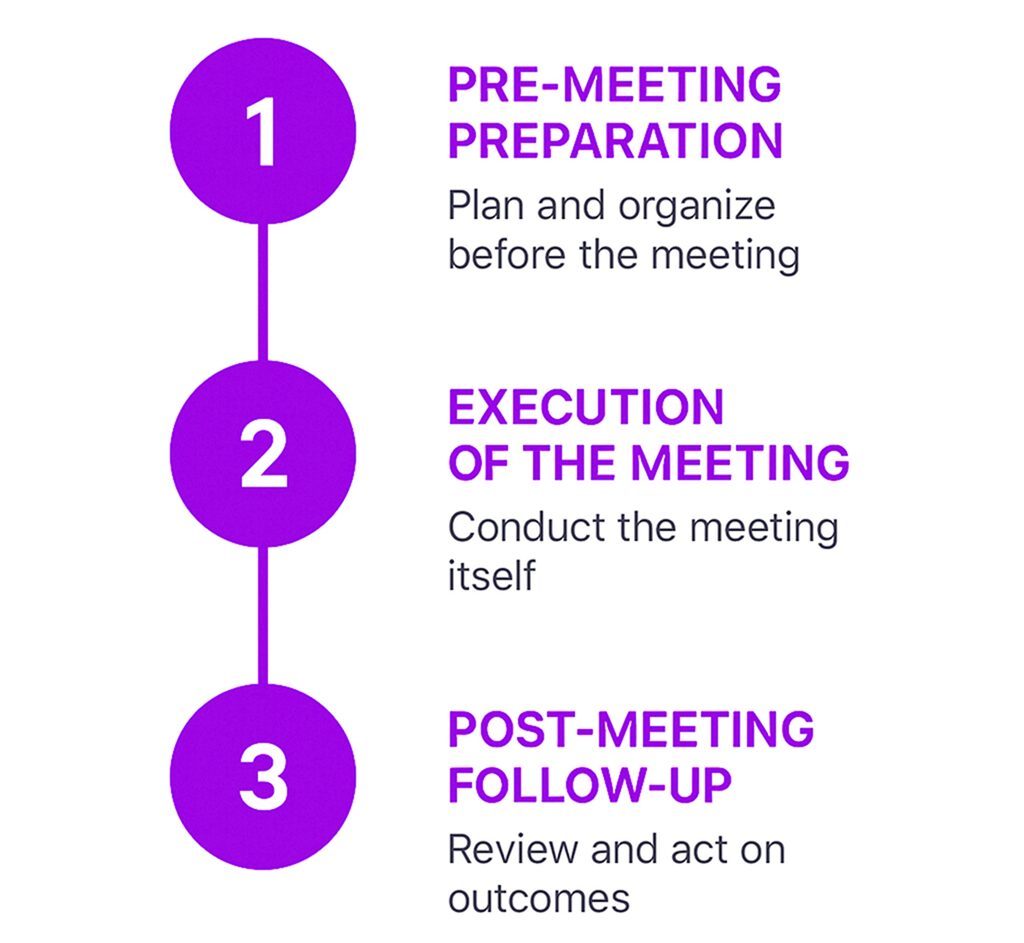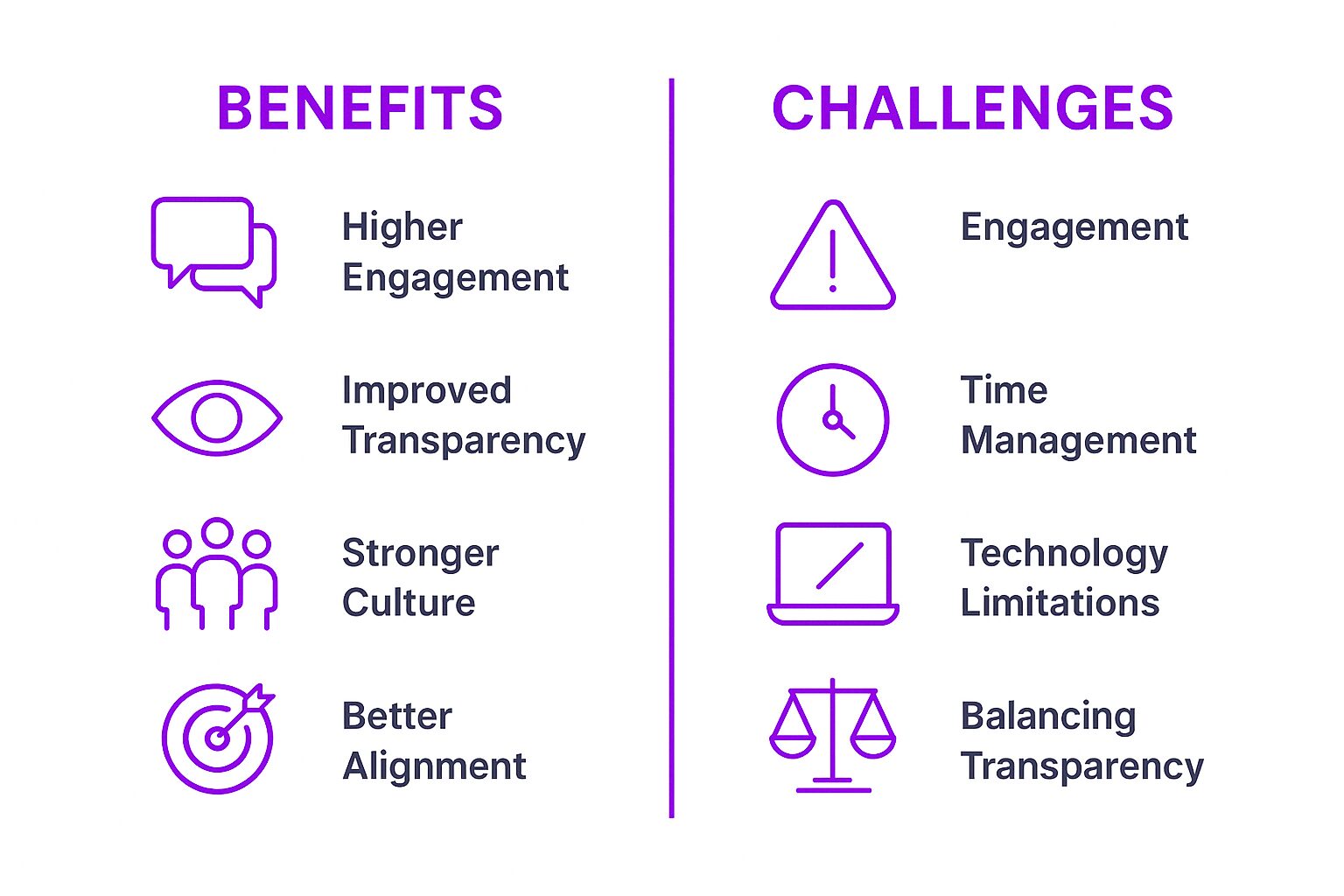What is a Town Hall Meeting?
A Town Hall meeting is an open forum within an organization where leadership addresses employees, providing updates, discussing key issues, and answering questions. Attending these meetings is crucial for engagement, as it allows employees to participate actively in the discussions. These meetings are typically informal and aim to foster transparency, encourage employee engagement, and provide clarity about the company’s direction. Often held in-person or virtually, Town Halls offer a unique opportunity for employees to engage directly with executives, ask questions, and participate in discussions that shape the company’s future.
Attendees can engage with the content through live video feeds, receive email updates about event recordings, and interact using translators or other apps, making their participation significant.
Town Hall meetings are an essential tool for building trust between employees and leadership, helping to bridge gaps in communication and ensuring alignment between the company’s goals and individual roles. These meetings may cover a range of topics, such as company performance, new initiatives, policies, and changes, but they also provide a chance to address employee concerns and foster a sense of community.
Why Are Town Hall Meetings Important?
Town Hall meetings have become a cornerstone of many successful organizations. Their significance goes beyond just a communication tool; they are an important part of fostering a positive and transparent company culture. Here are some reasons why Town Hall meetings matter:
1. Improved Communication
One of the primary reasons for holding Town Hall meetings is to facilitate direct communication between leadership and employees. By gathering employees in one place (virtually or physically), companies can provide updates on company goals, challenges, and initiatives. The audience participates actively by voicing their opinions and questioning leadership, which helps ensure that diverse views are heard and employees feel more connected to the business, especially in large organizations where regular communication might otherwise be limited.
2. Employee Engagement
When participants are given the chance to engage with leadership, it encourages a deeper sense of involvement. Employees feel heard when their questions are answered and their concerns addressed. Town Hall meetings provide a platform for open dialogue, which fosters trust and motivates employees to become more involved in the company’s goals and decision-making process.
3. Transparency
A Town Hall meeting promotes transparency within the organization. Employees often feel disconnected from leadership, especially in large companies, which can lead to misunderstandings and low morale. Town Halls give leadership a chance to address any concerns and communicate decisions, strategies, and company performance in a transparent manner. This openness helps build credibility and trust in leadership.
4. Team Alignment
Town Hall meetings ensure that all employees are on the same page regarding company priorities. Whether it’s changes in direction, upcoming projects, or goals for the year, Town Halls allow for real-time updates and help employees understand how their roles contribute to the broader company strategy. Aligning the team helps drive company-wide efforts toward shared objectives.
Key Stages of a Town Hall Meeting
A Town Hall meeting typically follows a structured format. Though the specific structure can vary, the key stages generally include preparation, execution, and follow-up.
1. Pre-Meeting Preparation
The first step in a successful Town Hall meeting is preparation. Proper planning ensures that the meeting is productive and engaging.
-
Setting the Agenda: Leadership should outline key topics to be discussed. Common topics include company performance, updates on key projects, challenges, and company culture initiatives. Employees may also be encouraged to submit questions or topics ahead of time, ensuring the meeting is relevant and that employee concerns are addressed.
-
Communication and Invitations: Employees should be notified well in advance of the Town Hall meeting. An agenda or topic list can be shared beforehand so that employees can prepare questions or thoughts. Sending a reminder a day or two before the event will help ensure high attendance. Employees can join the meeting by following the provided link, and their participation is crucial for a successful and engaging session.
-
Choosing the Platform: For virtual meetings, selecting the right communication platform is essential. Platforms like Zoom, Microsoft Teams, or Google Meet are ideal for large meetings as they allow for real-time interaction, question submission, and live polls.
2. Execution of the Meeting
The actual Town Hall meeting generally follows this flow:
-
Introduction and Opening Remarks: A member of leadership opens the meeting, outlining the objectives of the gathering. Often, the CEO or another senior leader will provide a welcome message and set the tone for the meeting.
-
Presentation by Leadership: Leaders often present updates on the company’s performance, discuss current challenges or opportunities, and share strategic plans. This is an opportunity for employees to understand the bigger picture, the vision, and how their work ties into the company’s future.
-
Employee Q&A Session: One of the most valuable components of a Town Hall is the opportunity for employees to ask questions. This might include concerns, clarifications, or ideas for improvement. Leadership should remain transparent and open to feedback, answering questions to the best of their ability. The Q&A should be interactive, either through live questions or questions submitted before the meeting.
-
Interactive Elements: To keep the Town Hall engaging, interactive components such as live polls, chat boxes, or breakout sessions can be incorporated. These tools allow employees to participate actively and share their opinions in real-time.
3. Post-Meeting Follow-Up
After the meeting, it’s essential to follow up to ensure the key points are reinforced and actionable steps are communicated.
-
Summary and Action Items: A follow-up summary email should be sent to all employees, outlining the key points discussed, any decisions made, and any action items. This helps to ensure accountability and keeps employees engaged with the outcomes of the meeting.
-
Feedback Collection: Gathering feedback after the Town Hall meeting is vital. This can be done through surveys or direct feedback channels, where employees can share their thoughts on what went well and what could be improved. This feedback can help improve future meetings.
Purpose and Importance of Town Hall Meetings
The purpose of Town Hall meetings is multifaceted. They are intended to align, inform, engage, and empower employees within an organization. Here are the main reasons they are so crucial:
1. Enhancing Communication and Information Flow
Town Halls allow employees to get the information they need directly from leadership, reducing the potential for rumors, miscommunication, or confusion. Leaders can share updates on key initiatives, strategic changes, and company performance, making the meeting a one-stop source of important news for the entire organization. Additionally, Town Hall meetings can be held across various locations within a district to gather feedback from a wider audience, emphasizing their importance in local governance and political engagement.
2. Creating an Open Dialogue
These meetings encourage direct, open conversation. Employees can ask questions, express concerns, and suggest new ideas. This open forum is an excellent way to foster trust, transparency, and a culture of continuous improvement.
3. Promoting Organizational Alignment
Town Halls help align everyone in the company with the same mission, vision, and goals. By communicating strategic objectives and company priorities, leadership ensures that every employee understands how their work contributes to the larger organizational goals.
4. Reinforcing Organizational Culture
Town Hall meetings are a great way to remind employees of the company’s values, mission, and vision. Leadership can use these meetings to promote culture-building activities, discuss the company’s impact, and address employee concerns to foster a sense of belonging.
Benefits and Challenges of Town Hall Meetings
Benefits
-
Improved Communication: Town Halls bridge the gap between leadership and employees, ensuring everyone is on the same page.
-
Increased Engagement: Employees who participate in Town Halls feel more connected to the organization’s objectives, which enhances job satisfaction and overall engagement. Members of the community or constituency play a crucial role in voicing their opinions and participating in dialogues around significant issues, fostering engagement and informing public officials.
-
Enhanced Transparency: Leadership can use Town Halls to explain decisions and strategies, fostering a sense of openness.
-
Stronger Organizational Culture: These meetings help reinforce the company’s values, mission, and vision, which strengthens its overall culture.
Challenges
-
Engagement: In larger organizations, maintaining engagement during a Town Hall can be difficult. Employees may lose interest or feel that the meeting doesn’t serve their needs. Ensuring that the meeting is well-attended can help overcome these engagement challenges by fostering a sense of involvement and participation.
-
Time Management: With so many topics to cover, Town Hall meetings can sometimes run longer than expected, leading to disengagement.
-
Technology Limitations: In virtual meetings, issues such as connectivity problems, technical failures, or user unavailability can interfere with the meeting experience.
-
Balancing Transparency and Sensitivity: While Town Halls encourage open communication, certain sensitive topics may require more careful handling or private discussions.
Practical Tips and Best Practices
-
Keep It Focused: Ensure that the agenda is clear, and stick to the planned topics. The focus should remain on the speakers and the essential information being shared. Don’t allow the meeting to become a free-for-all.
-
Use Interactive Tools: Leverage live Q&A, polls, or chat functions to make the meeting more interactive.
-
Be Transparent: Don’t avoid difficult topics. If there are challenges within the company, address them openly.
-
Engage Employees Before and After: Send out a survey to employees ahead of the meeting to gather questions or concerns. Follow up after the meeting with a summary and next steps.
-
Rotate Meeting Times for Global Teams: If your organization has employees in multiple time zones, rotate meeting times to ensure fairness.
Real-World Examples and Use Cases
-
Google’s Weekly Town Halls: Google’s founders hold weekly all-hands meetings, where employees can ask any question, and answers are provided directly. This practice has contributed to a culture of transparency and inclusivity.
-
Amazon’s ‘Ask Me Anything’ Sessions: Jeff Bezos has regularly hosted “Ask Me Anything” sessions with employees to address concerns, share company updates, and stay connected with staff. This level of accessibility has helped Amazon maintain a strong and unified culture.
-
Salesforce’s Virtual Town Halls: Salesforce hosts virtual town halls to engage with its global workforce. These meetings are an opportunity for employees to hear directly from leadership, share concerns, and contribute feedback about new company initiatives.
-
Historical Town Hall Meetings in March: Town hall meetings have played a significant role in political discourse throughout history. For example, a notable televised town hall meeting attended by President Carter took place on March 16, 1977. This event highlighted the importance of direct communication between leaders and the public, showcasing the evolution of town hall meetings over time.
Conclusion
Town Hall meetings are a powerful tool for fostering open communication, aligning employees with organizational goals, and building trust within the company. They promote transparency, engagement, and inclusivity, offering employees a unique opportunity to interact with leadership. Town Hall meetings have also been used to engage constituents in discussions about health care reforms, highlighting public sentiment and opposition to specific legislation, which often leads to significant attendance and vocal participation. While there are challenges, such as maintaining engagement in large organizations or managing technology during virtual meetings, the benefits—improved morale, stronger company culture, and better alignment—make them an invaluable part of any organization’s communication strategy. By embracing best practices and ensuring clear, actionable outcomes, Town Hall meetings can be a transformative experience for both employees and leadership.







